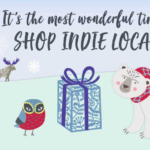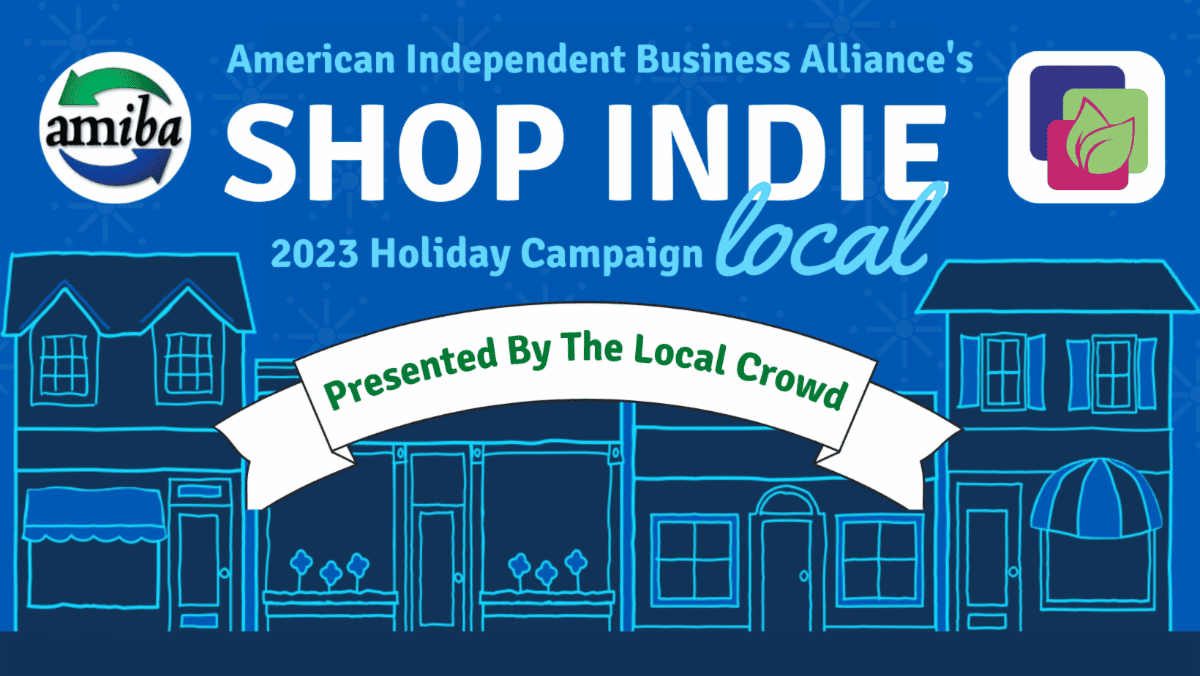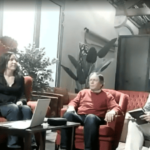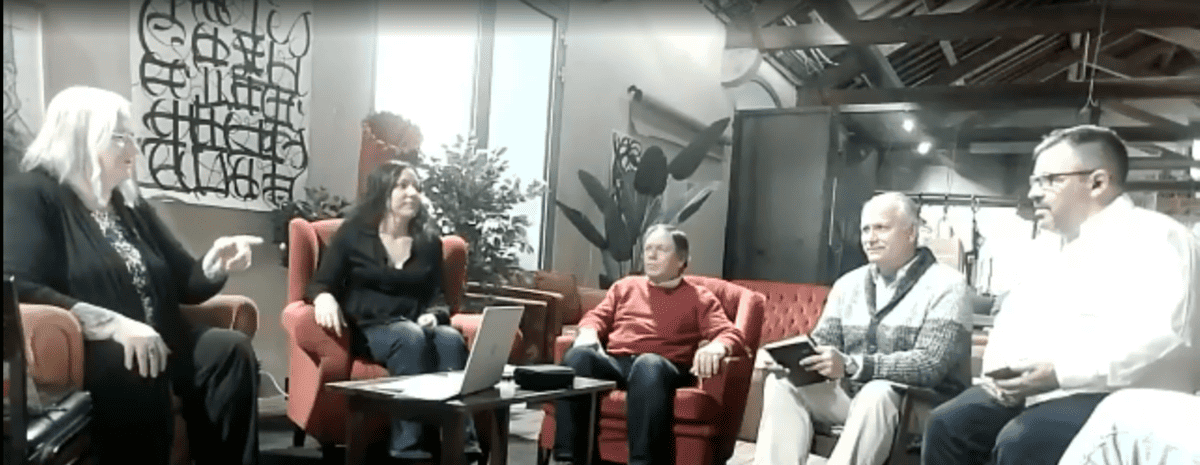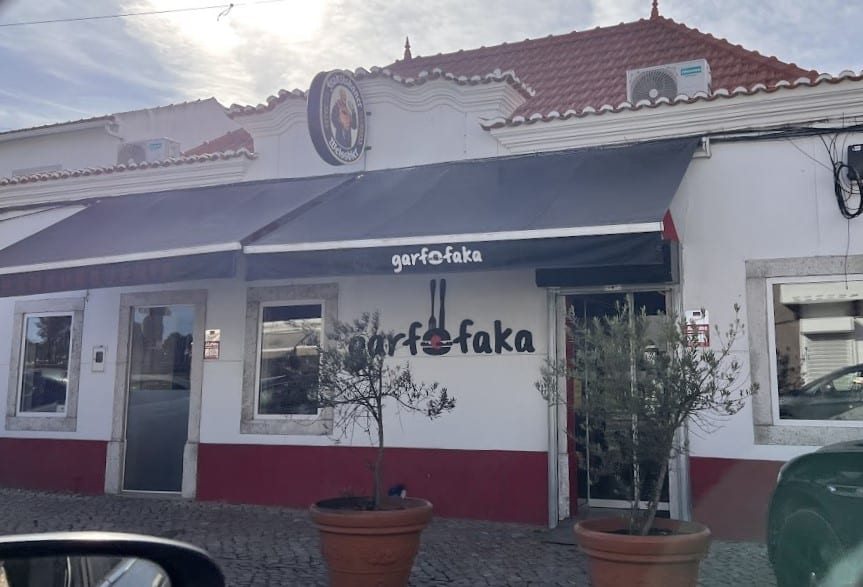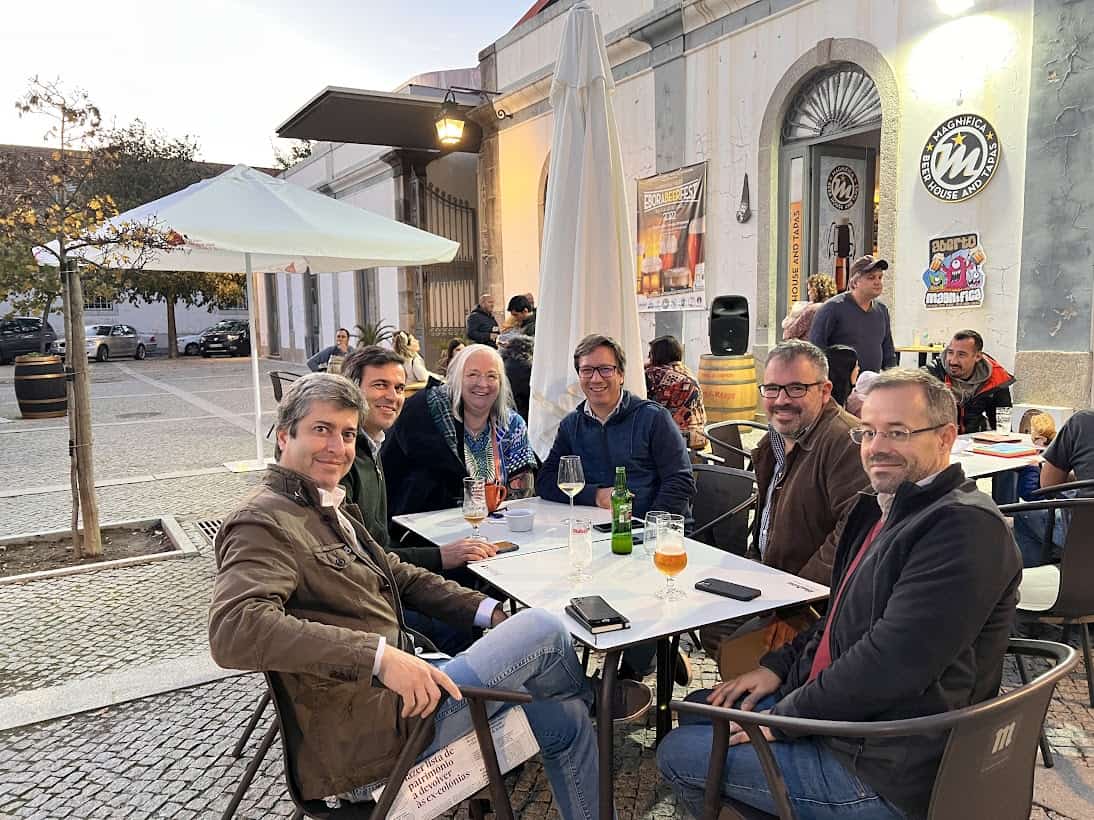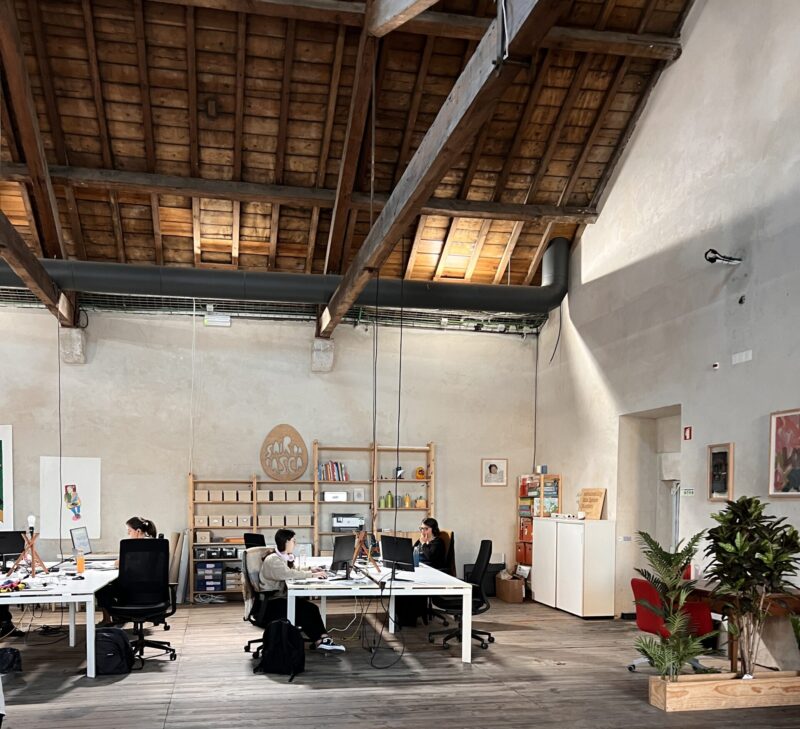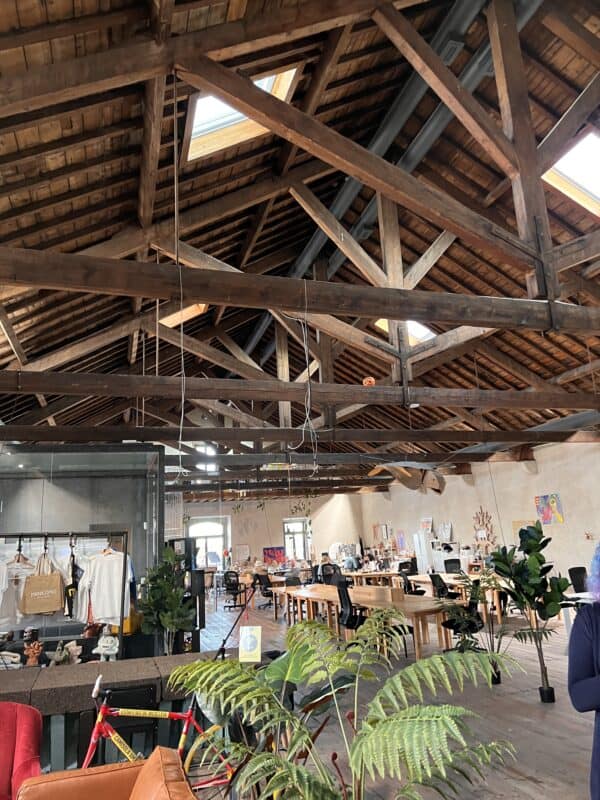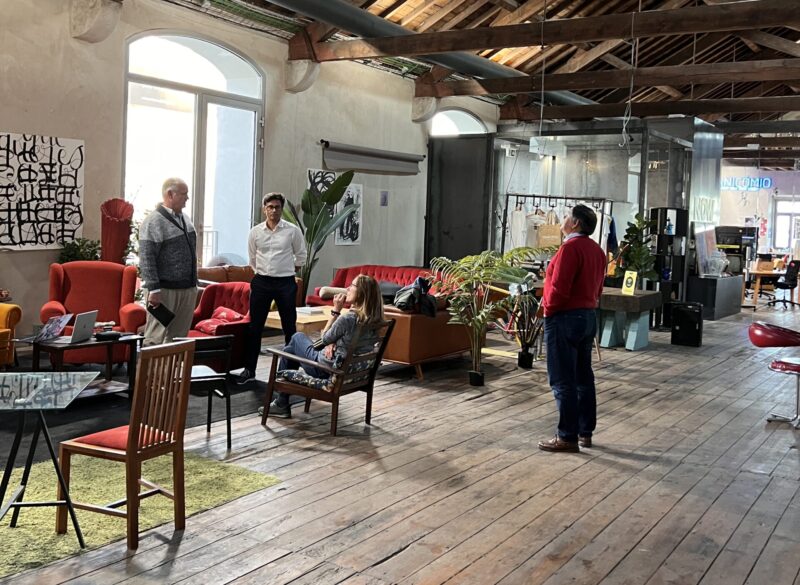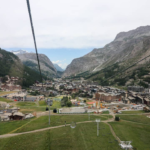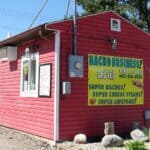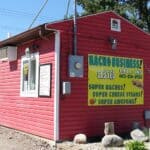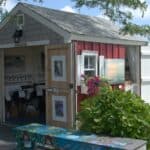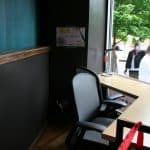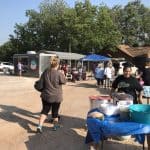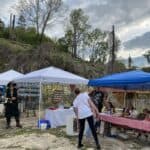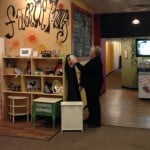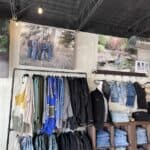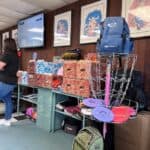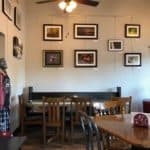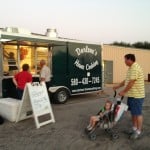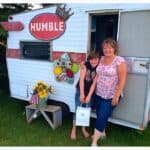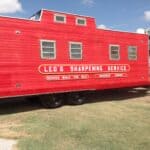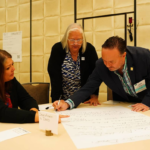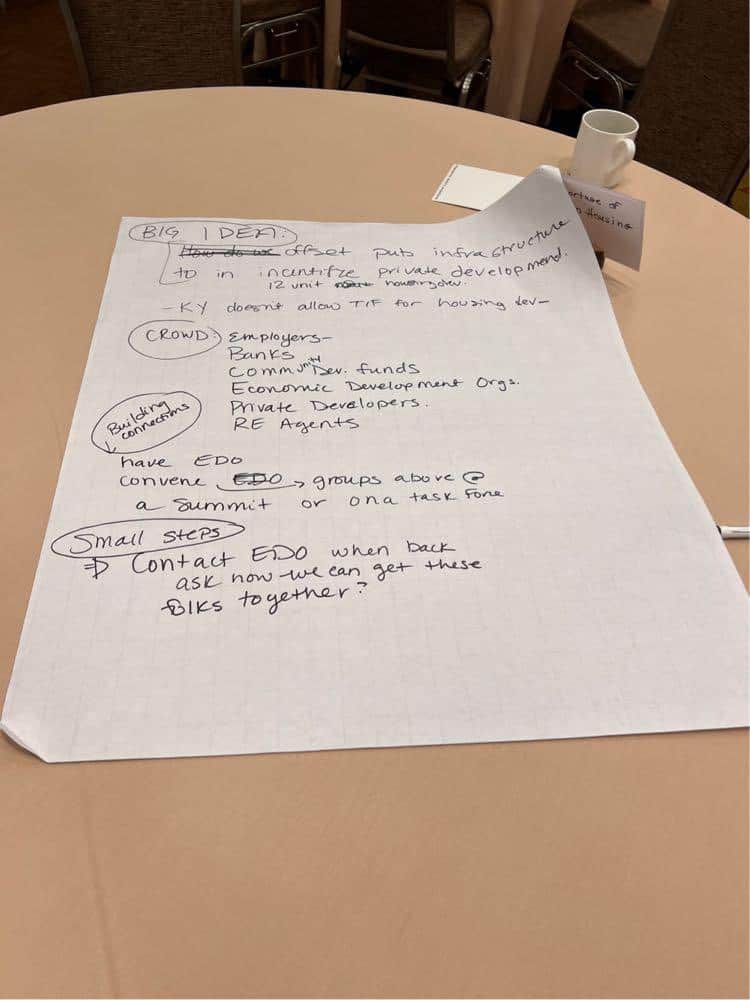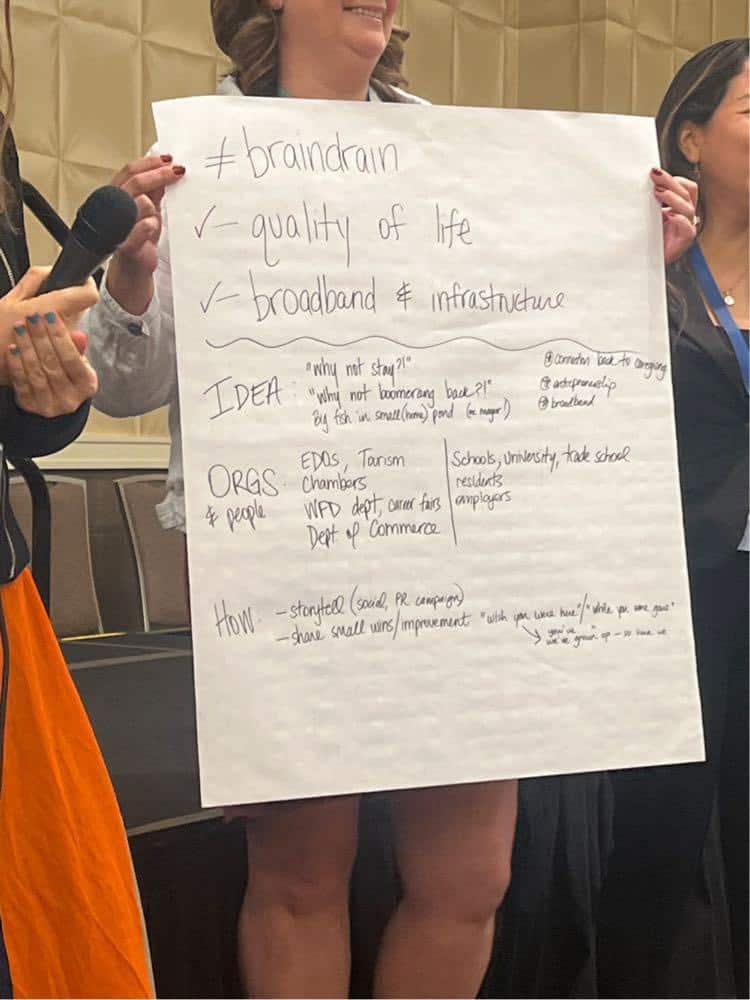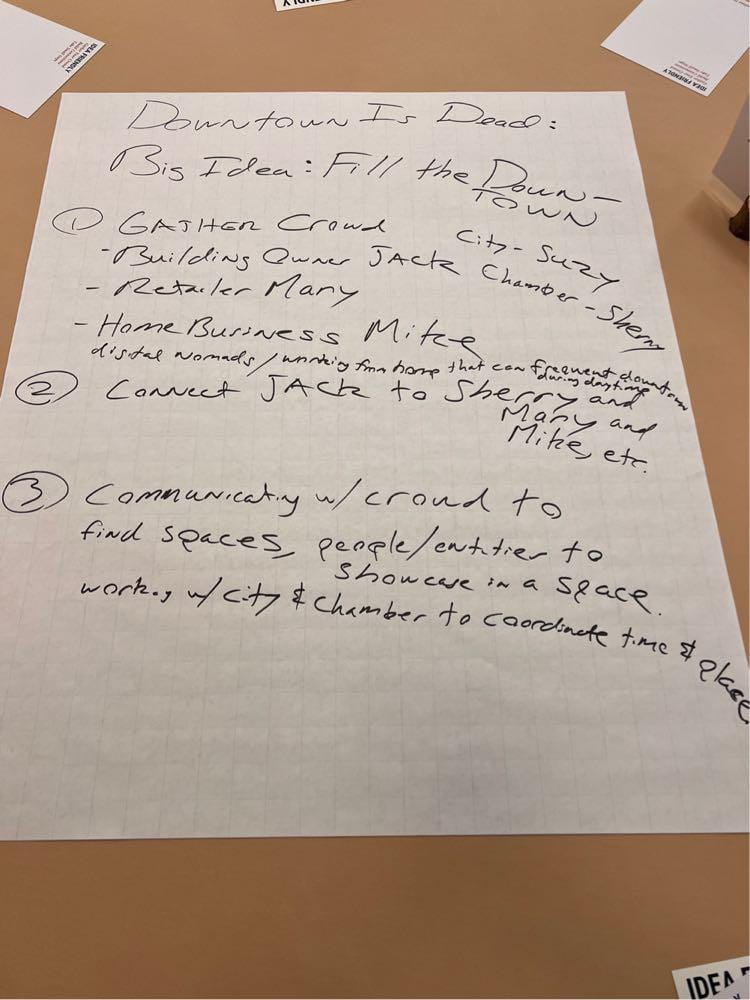Monthly Archives: November 2023
Shop Local tools: Easy Editorial, Letter to the Editor template to copy
Promote local shopping with a letter to the editor or editorial Step by step instructions Ready to promote local shopping to more of your community? Try an editorial or a letter to the editor. You can submit this to your local newspaper, share it in any organization newsletters, and post it on social media! Step […]
Promote local shopping with a letter to the editor or editorial
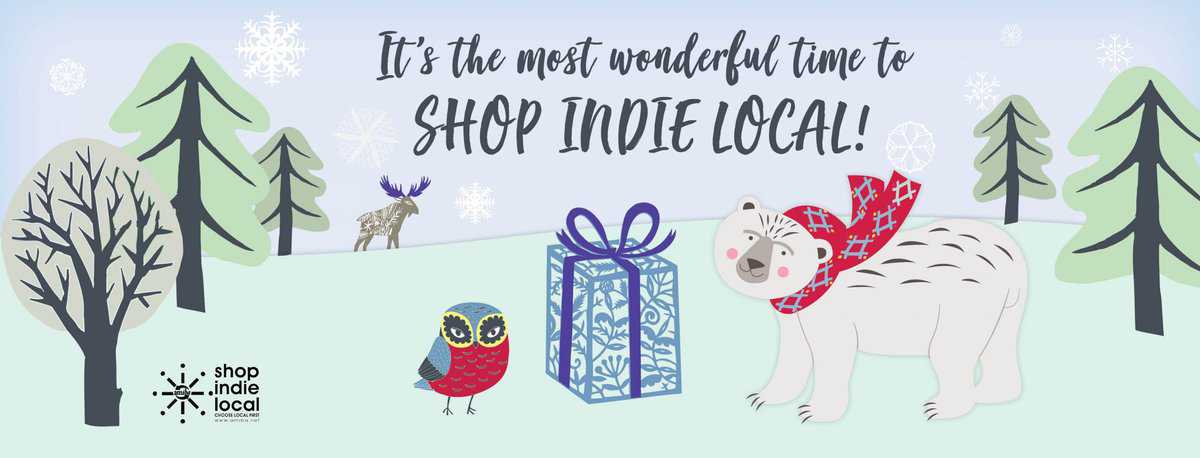
Step by step instructions
Ready to promote local shopping to more of your community? Try an editorial or a letter to the editor. You can submit this to your local newspaper, share it in any organization newsletters, and post it on social media!
Step 1. Easily grab these 3 simple numbers for your state or territory.
If you’re in the USA, go to Small Business Profiles at the Small Business Administration. Scroll down and click on your state or territory. You’re looking for these numbers:
- Number of small businesses
- Percentage of small businesses
- Percentage of employees
If you’re in another great country, try searching for each stat, like “Number of small businesses” plus the name of your state, territory or most relevant region. I just tried “number of small businesses New Zealand” and found out that there are 546,000 small business that are 97% of all businesses in New Zealand, plus they employ 29.3% of all employees.
Hot tip: Keep the PDF or website for your data open in a tab on your browser or on your phone, and it will be simple to find the numbers to fill in the template.
Here’s an example for the State of New Mexico:
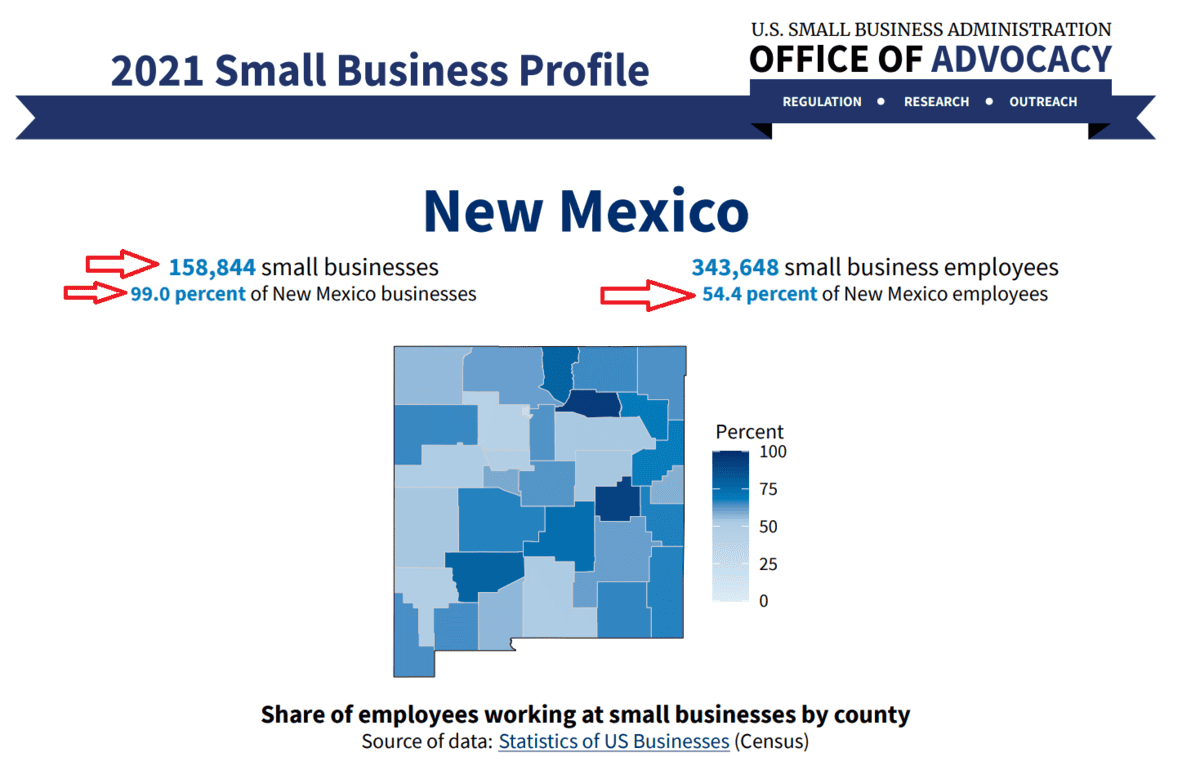
Step 2. Copy the template below to your favorite editor like Google Docs, Word, or even the notes app on your phone!
This template was provided by the Shop Indie Local promotion of the AMIBA – American Independent Business Alliance. They are a great resource for supporting local shopping all year long.
The Google Docs version of the template is here. (That link is subject to change in future years. If it’s no longer working, just copy the text from below.)
Step 3. Look for the sections in brackets {LIKE THIS} and fill them in.
You already know your state or territory name, and you just picked up those 3 simple numbers about small businesses. Just plop them into the note or document to customize it.
Step 4. Change any wording to make it sound more like you!
It’s ok to reword it, add something, or delete stuff that you would never say. The more personal you can make it, the better!
Don’t want to change a thing? That’s fine, too.
Step 5. Add a local story, or tell about a favorite local business.
The perfect place to do this is right after “entrepreneurial spirit.” Just start a new paragraph, and include a couple of sentences like this:
Holder Drug is the perfect example in our town. Not just the pharmacy, but also their amazing soda fountain! They’ve supported my family and yours for better health for generations, and they’re always one of the first donors to any local project.
Step 6. Submit it to a local newspaper.
Just email it to the editor or anyone you know at the paper. Check their website or a recent paper to find the email address. Or text a friend and ask!
Bonus points: Print it in organization newsletters.
If you belong to any club, church or organization, submit this for the next issue of the newsletter or email newsletter.
Double bonus points: Share on social media!
One super effective way to post on social media is to actually print out the letter on paper, sign it by hand, then post a photo of it to Instagram or Facebook with all the best local hashtags. And you can post the text in the comments. Multiply it by cross posting to local shopping or buy/sell groups on Facebook.
Don’t forget the #ShopIndieLocal hashtag!
That’s it! Ready to go? Here’s the template:
DRAFT Letter to the Editor Template: Shop Indie Local
In {ADD YOUR STATE/TERRITORY}, we pride ourselves on our independent thinking, ingenuity, and self-reliance — qualities reflected in our entrepreneurial spirit.
According to the Small Business Administration’s latest Small Business Profile, our state{OR TERRITORY} is home to more than {ADD NUMBER} small businesses (employing fewer than 500 people), comprising {ADD PERCENTAGE} percent of all {ADD YOUR STATE/TERRITORY} businesses.
Our small businesses also provide the most significant source of jobs across the state{OR TERRITORY}, employing {ADD EMPLOYEE PERCENTAGE} percent of all private-sector workers, compared to an average of 48 percent nationally.
Whether you run a business or not, we all have an essential role to play in supporting entrepreneurial success and community wealth. As many of us look to share gifts with friends, family, and coworkers, we also have the opportunity to give a gift to our community. When making holiday purchases, we ask you to “Shop Indie Local” and choose to spend your dollars at locally owned and independent businesses.
Why Shop Indie Local?
When you spend your dollars at locally owned retail businesses, more money returns to your local economy than if you spend that same dollar at a chain store. According to Civic Economics, when you spend a dollar at an independent business, about 48 cents returns to your local economy. (Spend it at a chain store and only 14 cents return; spend it at an online giant and only pennies return.) That 48 cents recirculate through a local economy, generating ripple effects that strengthen jobs, charitable contributions, and community prosperity. Capitalizing on this local multiplier effect is key to creating jobs and wealth in our community.
On the flip side, purchasing from Amazon or other remote online retailers provides virtually no economic benefit to our community. The American Independent Business Alliance calculates that 1 percent of the cost of an online purchase will go back into your community — only if the delivery person is a local resident.
Local, independent retail businesses help employ many more people than just those on the sales floor. They’re more likely to bank with your local banks and buy from other local businesses compared to absentee-owned companies. They’re also more likely to hire local service providers like accountants, graphic designers, sign-makers, webmasters, and various skilled positions — jobs for aspiring entrepreneurs.
Local non-profit organizations depend largely on contributions from local businesses. This support builds relationships that cement commitment to civic institutions like schools, churches, and fraternal leagues that aid economic prosperity, community cohesion, and trust.
If most of us shifted even one or two more purchases to independent, community-based businesses this season, we would create dramatic, positive changes in our local economies and help induce new jobs in our state{OR TERRITORY}.
So do yourself — and our community — a favor this year by shifting more of your spending to your local merchants, service providers, artisans, and locally owned and independent businesses. Along with helping your neighbors and community, you may just find that the Shop Indie Local spirit turns holiday shopping into a far more relaxing and enjoyable experience: one that rewards both you and your community.
{SIGN YOUR NAME HERE}
Shop Indie Local Week and Holiday Season, it’s way more than Shop Small Saturday
Guest post by Jen Risley, AMIBA Thank you for your commitment to building the local economy movement! Wishing you an inspiring Shop Indie Local Week with the entire community. My cat Shamu (above) can’t wait for Plaid Friday! One practical step: #ShopIndieLocal It doesn’t have to be overwhelming. Any local business or group can start by sharing social […]
Guest post by Jen Risley, AMIBA
Thank you for your commitment to building the local economy movement!
Wishing you an inspiring Shop Indie Local Week with the entire community. My cat Shamu (above) can’t wait for Plaid Friday!
One practical step: #ShopIndieLocal
It doesn’t have to be overwhelming. Any local business or group can start by sharing social media posts announcing your plans and adding #ShopIndieLocal to your posts.
Not just Saturday: Plaid Friday through Giving Tuesday
The week after Thanksgiving is a super busy one for the Shop Indie Local movement as we celebrate Plaid Friday, Small Business Saturday, Artists Sunday, Cider Monday, and Giving Tuesday.
Invite Independent Businesses to Plaid Friday
From TLC Monadnock: We invite businesses to serve as Plaid Friday Hubs in the Monadnock Region, NH. Back in 2009, what started with three hubs has grown to over thirty each year. View our invitation and adapt it to work for you!
Artists Sunday: Celebrating Local Artists, Creators, and Performers
From Artists Sunday: Artists Sunday, falling on November 26 this year, is the celebrated day after Thanksgiving dedicated to supporting local artists, creators, and performers. This year marks the fourth annual Artists Sunday, a unique shopping experience featuring over 4,000 professional artists and more than 500 non-profit art organizations, municipalities, and commercial entities across the nation.
“This Artists Sunday, let’s come together to celebrate and support the artists in our communities. It’s a day to fill our lives with beauty, creativity, and joy,” states Christopher V. Sherman, Executive Director of Artists Sunday
Why Cider Monday Matters
Celebrate Cider Monday to bring attention to the effects of online sales on your community. You love buying local, but the next thing you know … CLICK, you purchased that blender online from a business far from your community. It’s so easy! And your one purchase won’t really make a difference… or will it?
Unleash Generosity on Giving Tuesday
From Giving Tuesday: Whether it’s making someone smile, helping a neighbor out, or showing up for an issue or people we care about, we each have something to contribute. Identify your gifts, pick a cause that gets you fired up, and give back. Each seemingly small act turns a ripple into a wave of good, transforming society and building the world we all want to live in.
Get more ideas, graphics and support
When you become a partner for the holidays, you’ll join 150 Shop Indie Local Holiday Campaign partners from 42 states, including SmallBizSurvival! You’ll also find downloadable logos and other images. You can adapt our templates in Canva including Square Images, Banner Images and Mobile Video. There’s no deadline, and it’s definitely not too late to join.
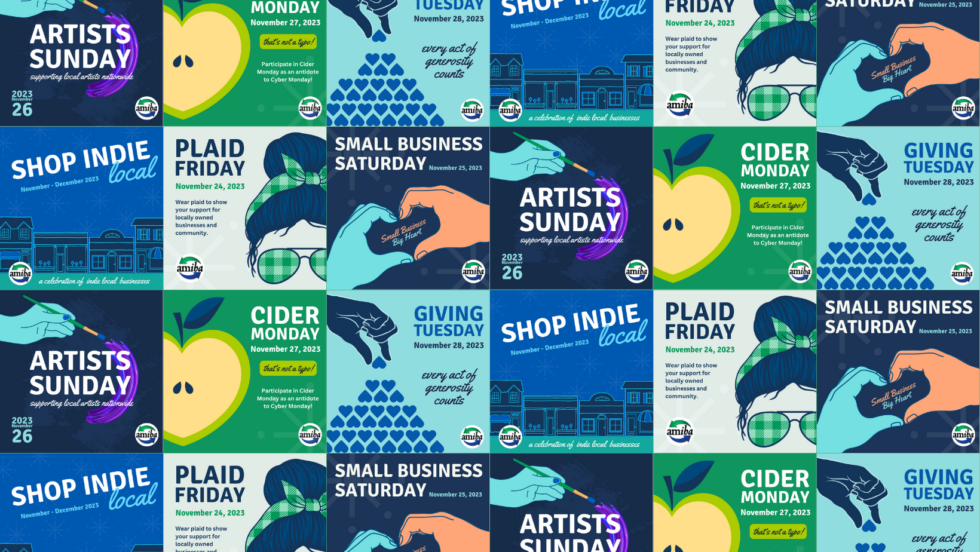
Get graphics and idea support from AMIBA Shop Indie Local.
Expand your November and beyond:
Native American Heritage Month
From First Nations Development Institute: Celebrate Native American Heritage Month with First Nations! This month and all year, we recognize and honor Native contributions, history, culture, and ingenuity. We’ll be sharing ways to support Indigenous leaders, authors, creators, and communities all month, including:
- How to be an ally to Native Americans by reclaiming Native truth and challenging stereotypes.
- Resources to learn about Native American heritage, culture, and issues.
- How to support Native-owned businesses in your holiday shopping.
- Opportunities for your donation to make the largest possible impact for Native communities.
Neighborhood Toy Store Month
From ASTRA: Local toy stores aren’t just places where families shop; they are centers of creativity, imagination, and learning.
Learn more: Neighborhood Toy Store Month
Join the Choose Indie Local Movement for the next year
Get ready for year-round ideas and support with next year’s Choose Indie Local campaigns. Our Choose Indie Local program inspires and supports community members to boost the ripple effect of economic and community benefits we receive when we spend and invest dollars at locally owned businesses. Let’s make ripples!
To give us a jump start, we’re announcing our 2024 campaigns today.
- Choose Black-Owned
- Choose Indie Sustainable
- Move Your Money: Bank Local, Invest Local
- Bicycling Means Business
- Choose Indie Pride
- Independents Month
- Eat Indie Local
- Choose Indie Art
- Shop Indie Local
Think of the list above as a menu of options. Choose the campaigns that align with your overall goals and sign on to participate in one, two, or all nine.
What partners receive:
You’ll receive a list of resources to help you establish your goals and leverage each theme you sign up for.
We’ll list your business/organization as a partner on our campaign webpage(s).
One month leading up to the campaign and weekly once our campaign starts, you’ll receive updates to inspire you and keep your campaign momentum strong.
Sign onto Shop Indie Local for 2024 .
Subscribe to SmallBizSurvival for more Shop Indie Local updates throughout the year.
GEW: Rural Entrepreneurship in small villages in Portugal – panel video
Part of our Global Entrepreneurship Week celebration Nov 13-19, 2023. Speaking about small businesses, entrepreneurship and sharing rural stories Story and photos by Deb Brown I was invited to speak in Portugal by my friend and business associate Frederico Lucas. My first night in Lisbon I spoke at this event hosted at the coworking space NOW […]
Part of our Global Entrepreneurship Week celebration Nov 13-19, 2023.
Speaking about small businesses, entrepreneurship and sharing rural stories
Story and photos by Deb Brown
I was invited to speak in Portugal by my friend and business associate Frederico Lucas. My first night in Lisbon I spoke at this event hosted at the coworking space NOW Beato and broadcast live on Facebook. Focused on rural entrepreneurship, the panel had a lively conversation about the possibilities for their rural areas. And meeting the challenges their depopulated communities have.
In today’s global economy, entrepreneurs are always looking for new opportunities to innovate and create value. Small towns and villages are often overlooked and also can be a rich source of local knowledge and expertise. However, engaging with these communities can be challenging for people outside them, especially in areas with low population density and depopulation.
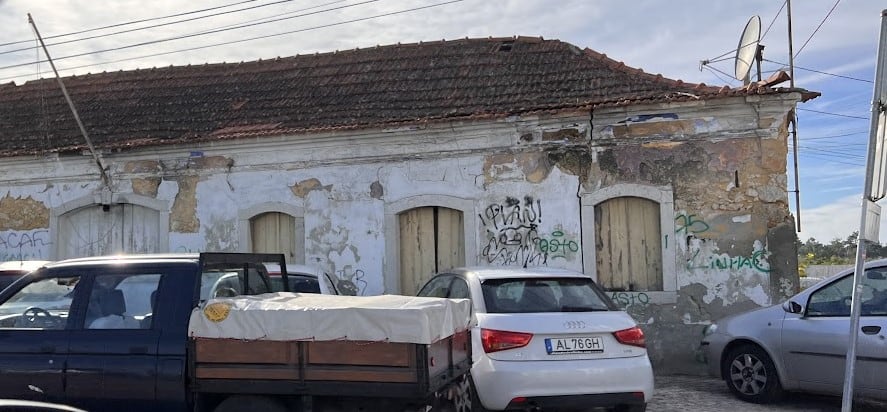
41 Small Villages Network Project in Rural Portugal
Ana Linares, from Novos Povoadores (“New Settlers”), and her team work with a group of small villages, 41 of them. There are very few people living there and few children, so the schools are closed. One town has 17 residents. Low density population is a problem. In the US we would call them ghost towns, in Portugal they call them depopulated.
Ana told us about this project. These 41 villages have created a network to develop tourism, but also to develop the community, and the social aspect of their economics. Because they are very small, if they were alone in trying to implement projects, it would be even more difficult. They started to organize and work together and use their synergies.
If one village has a festival, and another village has a walking trail, they can work together to offer a tourist experience that is more complete. Some towns have places to eat or sleep that can be added to the experience. Once the team connects with some of the few older people still living there, they find the community has great pride in their villages and is very open to innovation and doing new projects.
This initiative comes from the people in the community, not the municipality. As is the case in many small towns, they must start with what they have. The local government will not be the ones to begin the initiative. And the town is depopulated and doesn’t have the resources or people to get started. At least that is their belief. Often, there is no single group that wants to be responsible to start the project. Like in the United States, I’ve heard many people say, “The city ought to fix that.” And the people forget they ARE the city.

Christmas and community made this idea work
A successful example of this kind of project is the Christmas Village that asked for support and started with their own facilities and resources. Eventually the municipality joined in, but it was not quick.
This village is Cabeça, the first eco-sustainable Christmas village in Portugal. Supported by eco-design experts, local communities have engaged in the task of developing Christmas décor by using natural elements, agricultural and forest surplus, as well as wool from the Serra da Estrela Mountain area.
All the streets are ornamented with natural materials, and the town comes together a month or two before and works on all the ornaments and decorations. No plastic, only natural material. There is a large warehouse where all the ladies go to make the ornaments.
Capturing the stories
One inspiring example Ana talked about is the Museum of the Future, a new project in Portugal that captures the stories of people in small villages in video format. These stories have cultural, social, personal, and human dimensions, and can be used to inspire new ideas and products.
Places to work, meet, and celebrate for free
Another project Ana and her team worked on was reinventing and redesigning some small spaces for a handful of artists to work for free. They used circular economy design – where everything was designed and made with the local artisans in mind. Each artisan also has a retail space.
It’s also a space that is open to everyone in the village where you can have meetings and parties. It is a place to bring new people from out of the village. They can have the experience of what it is to live in a place that is open to artisans and community. There are many advantages to living in a place like this!
What does it take to be successful?
Engaging with small communities requires patience, empathy, and a willingness to listen and learn. It also requires a recognition that successful projects are not just about achieving technical goals, but also about building relationships and empowering communities.
One solution they use in Portugal is to adopt a co-creative and collaborative approach. By bringing the community along in every project, entrepreneurs can ensure that their initiatives are relevant, sustainable, and impactful. This approach also recognizes the value of people’s local stories and cultural heritage, which can be turned into resources for younger people to create new products or services, or to reinvent old ways of doing things.
Is this a utopian vision?
No. I don’t think so. Ana and the team at Novos Povoadores shared this remark on their website:
The globalized society is increasingly based on an economy without geography, a fact that allows us to look at the territory in a more inclusive way. In this context, it is possible to reduce the gap of regional disparities with advantages for new residents and for low-density territories. On the one hand, an undeniable increase in the quality of life, and on the other hand, the breaking of a cycle of territorial bleeding.
Photos from the coworking space NOW Beato in Lisbon, Portugal
Where the panel discussion was hosted.
Subscribe to Small Biz Survival.
Surviving the Peaks and Valleys of Seasonal Small Business in a Rural Ski Town
Part of our Global Entrepreneurship Week celebration Nov 13-19, 2023. Guest post by Mike Humphrey, Japan Skiing has been part of my life for as long as I can remember. I don’t know why my parents decided skiing would be our family sport. They were not avid skiers, and we didn’t live in a ski […]
Part of our Global Entrepreneurship Week celebration Nov 13-19, 2023.
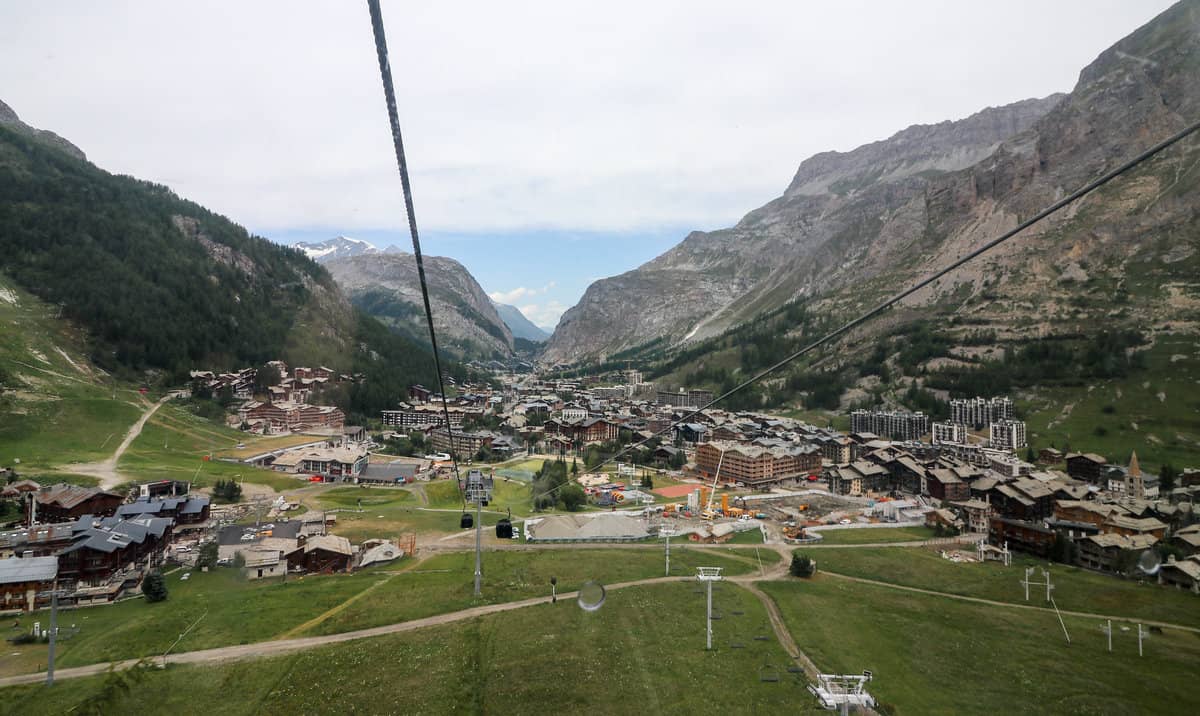
Photo CC by Joanbrebo
Guest post by Mike Humphrey, Japan
Skiing has been part of my life for as long as I can remember. I don’t know why my parents decided skiing would be our family sport. They were not avid skiers, and we didn’t live in a ski town. Whatever the reason, I was on skis at 3, and my love for the sport began. We would spend every weekend in the winter on the hill.
When I was 15, I became a ski instructor. Skiing is my passion. I love being out on the hill, and I love the mountains.
As I grew older, skiing was still part of my life, but it became a hobby. I went to university and got a job. I started a family, and things were going well. I would ski weekends at our small local hill, but it was slowly being relegated to an afterthought.
That all changed seven years ago when I left my corporate job. It was time for a life choice: continue with my career or make a change. With some savings in our account and dreams of powder turns, I leapt. I left my job and moved our family to a ski town in Japan.
It has been seven years since we moved to the mountains, and it has been filled with joys, challenges, and, of course, skiing. In that time, we have operated two hotels and a restaurant and weathered the storm of Covid. It has been a hell of a ride, and not without its difficulties. Despite the challenges, I would never return to working a corporate job.
Read on to discover the challenges we faced while building a business and our dream life in a small mountain town.
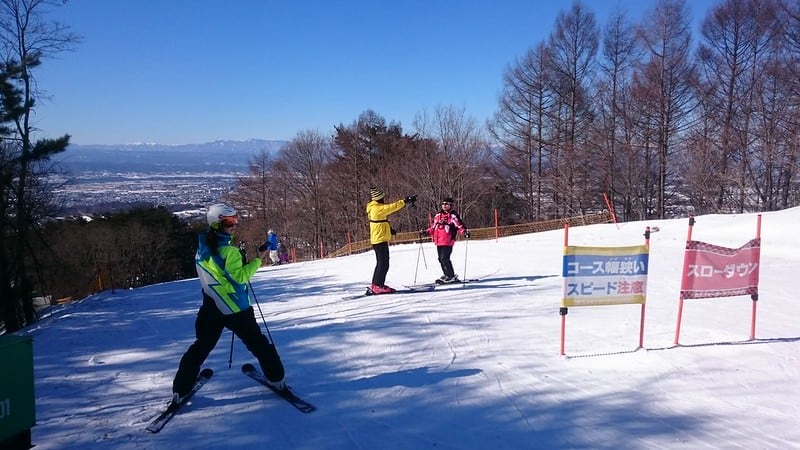
Photo CC by Cookie M
The Challenges of Running a Small Business in a Ski Town
1 – Seasonal Customers
The highs and lows of running a business in a seasonal destination, whether a ski town or a beach destination, are extreme. During the winter, the city’s population triples in size. In the span of 4 months, we get 400,000 tourists visiting our small village of 5,000 people.
The influx of customers is terrific for business but not always for sanity. Imagine the demand for your products skyrocketing for four months and then crashing back to almost zero as soon as the snow starts to melt.
As a business, you need to develop systems and processes to adapt to the extreme shifts in market demand.
Choosing a Business Model
There are generally two models to choose from when you decide what business to run. You can cater to tourists, or you can cater to residents. The best businesses are the ones that can manage to do both.
Catering to Travelers
With this model, you fully embrace the higher-paying tourists. You charge higher prices and focus on optimizing your returns for tourists. During the low times, you minimize your expenses and either shut the business down or drop prices and try to scrape by attracting lower-paying guests.
This is how we operated when we ran our hotel. We were very strategic with our opening dates and only worked during the peak season. During the slow times, we shut down the hotel, went into maintenance mode, and did upgrades.
This worked well when there were lots of guests, but if you have a terrible snow season or a global pandemic, for that matter, you can run through your reserves quite quickly.
Catering to Local Customers
Your goal here is consistent revenue throughout the year. You have to choose your prices to match the local market. Your customer base is smaller during the low season, but during the high season, your revenue jumps drastically.
This is the model we use to run our restaurant. We live and work in the community year-round and provide good food options at reasonable prices regardless of the season.
By establishing relationships with residents and business owners within the community, you can develop a strong clientele that will sustain you throughout the year. Those relationships help you to flourish during the high season when residents recommend your services to travelers in town.
Catering to Locals and Tourists
Matching both markets is a tricky needle to thread, and I haven’t seen many businesses do this successfully. Essentially, you must provide a service that can increase prices during peak times without alienating local customers. The closest we came to this was with the hotel, which had peak and low-time pricing. But this isn’t catering to local businesses; it’s just modifying your pricing to match traveler demand.
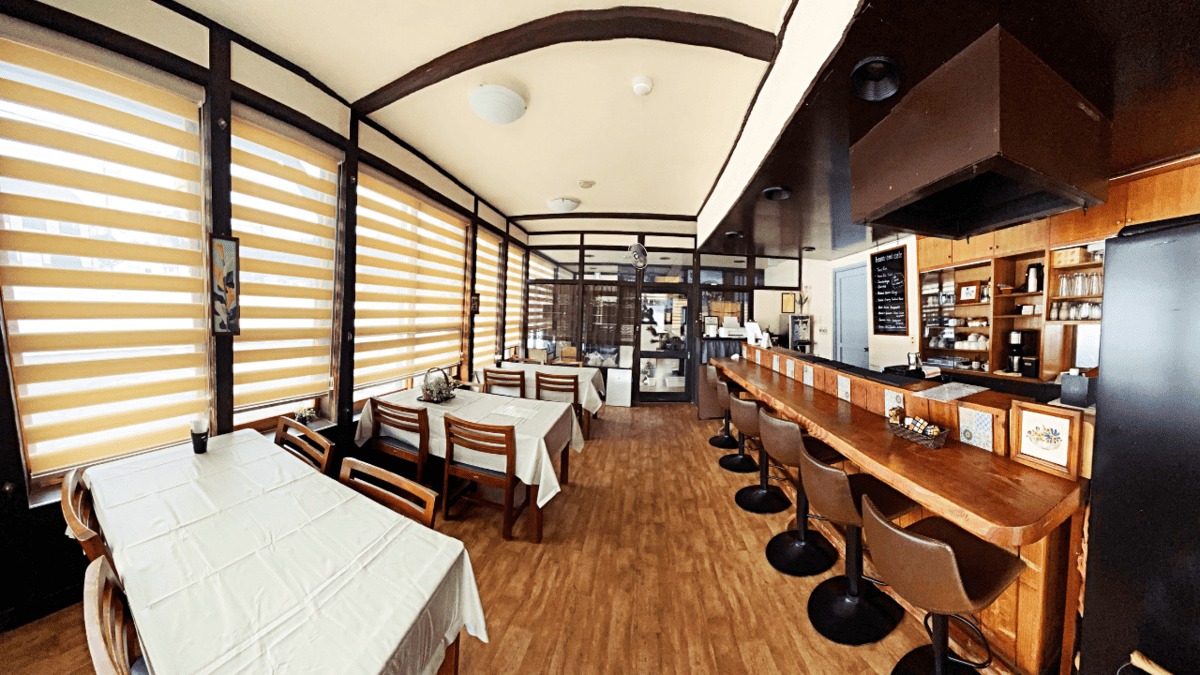
Photo provided by Mike Humphrey
2 – Staffing
Ski towns have some unique staffing issues that can be challenging for small businesses to overcome. The small local population combined with the boom and bust market makes staffing one of the most difficult things to deal with.
Staff Training
In a ski town, the money-making window is short, and staff is transitory. We hired 5 – 7 staff during peak season to help run the hotel. They would arrive early to mid-December, 1 – 2 weeks ahead of our first guests.
We rarely had repeat staff, and they had to be fully trained before the Christmas rush. It was trial by fire. You have to get them up to speed in 2 weeks so they can provide the best customer service possible. When the guests do start to arrive, it’s crunch time. You are running at full capacity almost immediately.
It’s the perfect storm. You need to hire the right people and have outstanding training programs and processes in place so they can hit the road running as quickly as possible.
Finding Good Staff is a Challenge
While this may be true for any industry, working in a ski town is appealing because you can ski. There is always a balance between finding a good employee and their desire to hit the hill.
As soon as the ski season starts, it’s too late to hire someone new. You better find the right people at the beginning and make sure they are doing a good job. Having to fire underperforming staff mid-season is a considerable risk.
You have to weigh the negative impact of keeping the employee on versus the risk of being short-staffed.
I have been through both experiences, and it was better to let the person go instead of hanging on.
Here are some tips for finding good staff.
Ask For Recommendations
Ask previous and current employees if they know anyone who would be a good fit. Check with friends and family or other business owners in the area.
Watch Out For Red Flags
Trust is critical; skills can be taught, but trust and work ethic can’t. During the interview process, look for signs that there may be issues. Identify them immediately and be upfront. Don’t move on until you feel entirely comfortable.
Check references. Call them and have an honest conversation. Ask what issues they had with the employee.
Use Contracts To Your Benefit
An employee contract goes a long way to establishing a good relationship with an employee. Reviewing and signing a contract makes your relationship official and keeps your employees committed.
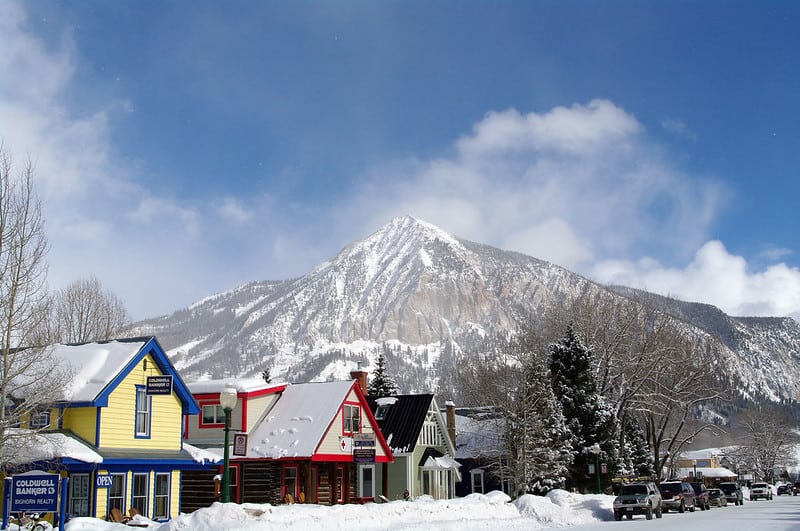
Photo CC by lamoix
Retaining Staff
The boom-bust nature of the ski industry means you can’t always keep staff all year long. The business can’t sustain employees during the low season. You always run a skeleton crew during the off-season and go into maintenance mode.
This means retaining good employees is hard. Expecting people to stick around and barely make enough money to live is unreasonable. Here are some ways to keep staff all year round.
Provide Extended Vacations
Give staff the chance to take time off during the shoulder seasons. They can take the opportunity to travel or go home to see family.
Reduce Staff Living Expenses
Consider alternative living arrangements or provide food through your business.
Collaborate with another business and offer a trade. Provide your services in exchange for cheaper accommodation for your staff.
It’s Hard Work
You have to make hay while the sun shines. For 4 – 5 months, you run flat out. Not only that, it’s playtime as well. You want to be out on the hill as much as you want to run your business. It’s easy to be understaffed and run your employees ragged. It’s a 4-month whirlwind of activity that can be hard to handle.
The critical takeaway is good hiring, training, and processes/systems. Watch for red flags when hiring staff; do not ignore your feelings about people. Don’t get me wrong, I have had some exceptional employees, but I’ve also had some horrible ones. Getting staffing right is crucial to making your small business work in a ski town.
One-on-one Training
When you’re in the thick of things, spending an hour or two with your employees teaching them may feel like a waste of time. But this is time well spent. An hour now could save you 10 – 20 times that time later in the season.
Learn From Other Businesses
We have friends who manage a hostel. They offered to take us through the building to show us how they managed their property. Here are some of the changes we made:
- We added a self-check-in process for late arrivals
- Better Signage
- Better local information Kiosk
Hire an Expert
If you’re unsure how to get better, find someone who has done it before and offer to pay them for their time. Have them watch how you run your business. Then, get them to make recommendations on how to improve.
Lessons Learned
After the season, talk with your employees about how things went. What things did you do well, and what could be improved? What pain points did the employees experience? Your perspective and the perspective of your employees will be different, and it’s essential to record what you learned.
Document
Solid documentation can be a great way to leverage your knowledge and compound your efforts. Keep records of everything you do. I like to use a Google Folder to build up a library of procedures. Whenever I need to use it, I review it and try to improve it. Things to document:
- Role Descriptions
- Job Postings
- Marketing Materials
- Standard Operating Procedures
- Annual Schedules
- Maintenance requirements
- Licensing renewals
This list will depend heavily on the type of business you run.
Implement
Last but not least, implement. If there is no action or change, then nothing will improve. I like to use project management software like Asana or Wrike to break everything down into manageable tasks. It will eventually get done as long as it’s written down and recorded.
3 – Cashflow Management
Cashflow is king, and managing your finances through a ski town’s boom and bust cycles is tough. Your business depends on tourists arriving at the start of the season to keep it running.
Building a reserve that sustains your business throughout the year is essential. But you also need to balance this against re-investing in your business. Cash sitting on the books doesn’t help your business grow and expand.
4 – Work-Life Balance
Running a business in a ski town is not all fun and games. You must be organized, stay on your toes, and manage your time well. It can be easy to get overwhelmed by the pace.
You can use the winter playground if you manage your business well and have the right staff. However, if you don’t, you will run yourself ragged, trying to keep everything afloat.
Final thoughts from a seasonal business
So, if you’re considering launching a business in a ski town, remember these points.
First, be prepared to put in a lot of hard work. It may not seem glamorous, but running a ski town business takes dedication and determination.
Second, be mindful of costs and stay on top of your finances. Knowing what you’re spending and where it’s going can help ensure you stay profitable.
Third, hire and train the right people to help you build a successful business. Finding and building a great team will make your life more enjoyable in the long run.
Finally, take advantage of where you live. Enjoy the mountains, the people, and all a ski town offers. It’s an incredible experience and one you won’t want to miss out on. I have seen too many business owners forget why they started their business and don’t get out and enjoy the lifestyle.
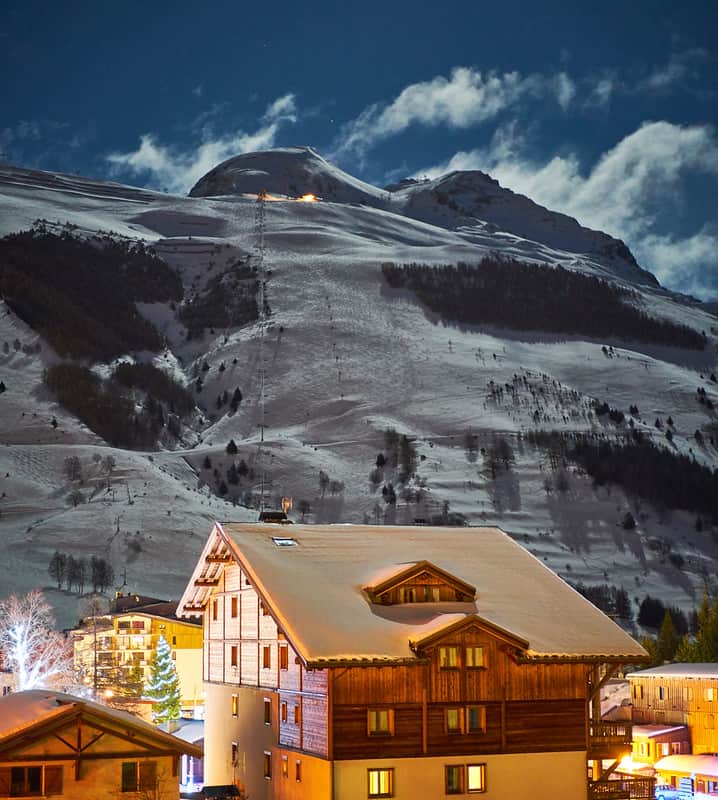
Photo CC by Radek Kucharski
Frequently asked questions: seasonal business
What are the peak seasons for running a business in a ski town?
The peak seasons are typically winter and summer when people come for skiing and summer outdoor activities.
Is it possible to maintain a steady income all year round in a ski town?
This largely depends on your business model. Some businesses are seasonal, while others offer services that are in demand year-round.
How do I attract local customers in addition to tourists?
Offering locals-specific discounts, involving your business in community events, and building a solid local reputation can all help attract local customers.
What challenges should I expect when running a business in a ski town?
Challenges may include:
- Dealing with the seasonal nature of business.
- Maintaining a steady workforce.
- Managing cash flow
How important is fostering relationships with other local businesses in a ski town?
Very important. Strong relationships with other businesses can help you stay informed about local trends, collaborate on joint initiatives, and create a support network.
Any advice on maintaining work-life balance while running a ski town business?
Schedule regular breaks, get involved in local activities, and ensure you take time for yourself and your family. Remember, enjoying your surroundings is part of the ski town experience!
About the author Mike Humphrey
Mike Humphrey is a writer and entrepreneur. He has operated several hotels and restaurants and founded mykhumphrey.com, where he writes articles about business, freelancing, remote work, and living abroad.
Innovative Rural Business Models: video
Part of our Global Entrepreneurship Week celebration Nov 13-19, 2023. Rural business people are trying a variety of different business models today, including pop-ups, shared buildings, businesses inside of other businesses and more. Entrepreneurs are using these smaller-scale experiments and tests to learn what works before making a huge investments. Learn how these Innovative Rural […]
Part of our Global Entrepreneurship Week celebration Nov 13-19, 2023.
Rural business people are trying a variety of different business models today, including pop-ups, shared buildings, businesses inside of other businesses and more. Entrepreneurs are using these smaller-scale experiments and tests to learn what works before making a huge investments. Learn how these Innovative Rural Business Models are being used right now in small towns in this video from the RuralRISE speaker series, featuring Becky McCray and Deb Brown, co-founders of SaveYour.Town
Innovative Rural Business Models, Becky McCray and Deb Brown, RuralRISE Virtual Speaker Series, 2023 (59 minutes)
Download the sample lease agreement (PDF)
The sample lease agreement for a shared building is one that we were given permission to share with others. Please have your own legal representative make a specific lease for your situation.
Would you like a presentation on the Innovative Rural Business Models?
Invite Deb and Becky to your town or event for a presentation or workshop.
Pop Up in An Empty Lot
Part of our Global Entrepreneurship Week celebration Nov 13-19, 2023. Starting a business the old way is hard On an Idea Friendly visit to Jackson County, Kentucky, I visited with a group of artists/entrepreneurs. This group had created a loose organization called the Jackson County KY Creative Community. They wanted to start businesses, but were […]
Part of our Global Entrepreneurship Week celebration Nov 13-19, 2023.
Starting a business the old way is hard
On an Idea Friendly visit to Jackson County, Kentucky, I visited with a group of artists/entrepreneurs. This group had created a loose organization called the Jackson County KY Creative Community. They wanted to start businesses, but were not ready to get a building and go through the extensive process of starting a business. Some needed to see if their work had a market and value to the customer. They felt stuck. Product and excitement, but no money to get their businesses off the ground.
Smaller steps to try first
We had gathered in an art studio in McKee, KY. There was lots of discussion around taking smaller steps to start your business.
- You could sell online in places like Etsy or eBay.
- You could ask a local business if you could have just one shelf to sell your product on.
- Or showcase your artwork on an empty wall in a place like the bank, or the insurance agents office.
- You could set up a card table at an event and sell from there.
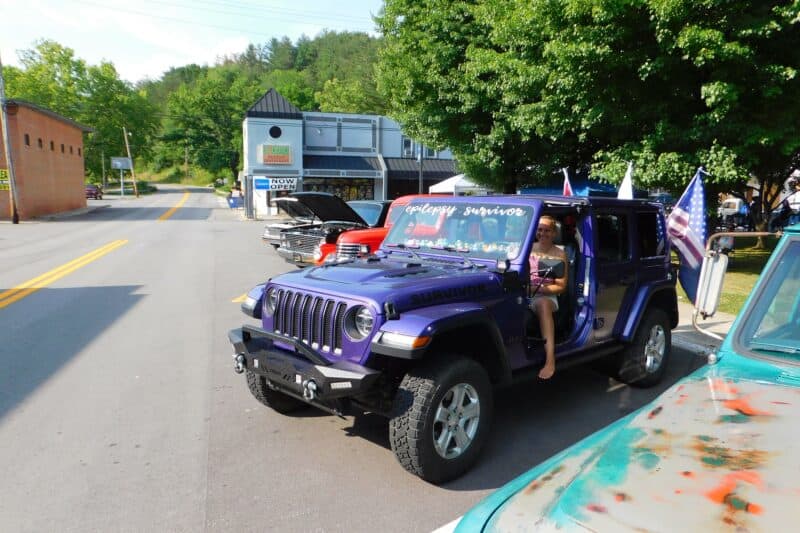
Downtown McKee, KY, car show photo by Anthony Jackson
Try using an empty lot
The group shared there was a car show coming to town soon. How could they piggyback on that event? There was an empty lot right downtown on the main highway, right across from where the cars would be parked. It wasn’t the best looking lot, it needed some attention. There was kudzu climbing the walls of buildings next to it, graffiti on the same buildings and the weeds needed some major whacking.
Ask
Kathy Spurlock owned the empty lot. I had already visited with her. I knew her time was already stretched thin, and her funds were being used for other community projects. Still, there was this empty lot waiting to be filled.
I asked her if the artists in the Jackson County KY Creative Community could possibly use it for a popup.
She said yes
The empty lot pop up was created! One artist’s husband took his weedwhacker and cleaned out an area just big enough for pop-ups. Everyone in the group spread the word a pop up was coming through social media and word of mouth. Other artists were invited. Signs were posted around the county. No one person was in charge, everyone participated as best they could.
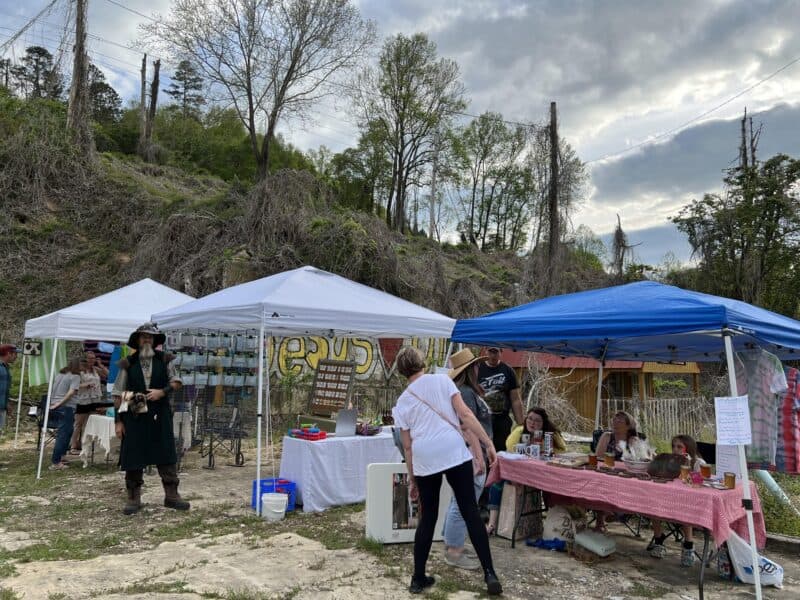
Empty Lot Pop Up photo by Greg Lakes
It worked!
There were many entrepreneurs set up with their works displayed. Folks came and bought from them, enjoyed the car show, and ate some food from local vendors. The Jackson County Creative Community added more artists as members too. There were lessons learned.
- You can pop up anywhere.
- It’s a good idea to join in another event and promote them both for more attendees.
- People are looking for something new and unique to do. Your excitement brings them in.
- Entrepreneurs come in all shapes and sizes and offering this kind of small step helps create more businesses in your community.
- Business can be conducted in unusual locations and empty lots are great testing grounds.
- It’s a small step. If it doesn’t work, you haven’t lost anything.
Entrepreneur week advice for small towns: 3 practical steps for economic developers and chambers of commerce
Part of our Global Entrepreneurship Week celebration Nov 13-19, 2023. Last year during entrepreneurship week, I saw lots of articles about what big cities can do to support entrepreneurship. Advice for small towns got left out. Again. So I wrote this entrepreneur week advice for small town economic developers and chambers of commerce, whether you […]
Part of our Global Entrepreneurship Week celebration Nov 13-19, 2023.

Last year during entrepreneurship week, I saw lots of articles about what big cities can do to support entrepreneurship. Advice for small towns got left out. Again.
So I wrote this entrepreneur week advice for small town economic developers and chambers of commerce, whether you serve 5,000 or 500 in your local population.
1. Create small spaces for entrepreneurs
Divide big buildings into shared retail spaces, garage-sized shops, small storage rooms for makers, and super affordable coworking for offices. These smaller spaces help keep startup costs down so entrepreneurs can grow to their next step. Then if a next step doesn’t work out, it didn’t require big financing and failure doesn’t have to mean financial ruin.
2. Recognize your artists and artisans as entrepreneurs with real economic value.
Support their efforts to sell online and at regional events. Create and support shared artist studios, workshops and galleries. Incorporate local artists into events and celebrations. Pay local artists and artisans for their work and creations.
3. Boost your food business ecosystem.
Find out about and support your growers, farmers, processors and markets. Expand the market for local foods by getting more local foods in front of more people. This includes your local residents and your visitors because both groups love to eat local.
Deb Brown and I made a 25 minute video on Food Business Ecosystems that is available for purchase at SaveYour.Town
Rural entrepreneurs start small to succeed: Global Entrepreneurship Week
Part of our Global Entrepreneurship Week celebration Nov 13-19, 2023. Find this and other Global Entrepreneurship Week events listed on the official calendar at GenGlobal. The old way to go into business Imagine all the work that goes into starting a new business. You need to be a good business manager, a marketing guru, and a […]
Part of our Global Entrepreneurship Week celebration Nov 13-19, 2023.
Find this and other Global Entrepreneurship Week events listed on the official calendar at GenGlobal.
The old way to go into business
Imagine all the work that goes into starting a new business. You need to be a good business manager, a marketing guru, and a financial wizard. You need to have great credit, have plenty of your own money, and you better know the right people. You need to have all your ducks in a row.
It takes a lot of time, money and work just to get into business.
The new way is to start small
Now imagine building some steps in between. If you could buy just a few products and test them by renting a booth at a festival, you’d learn more about what works. You could run a temporary business inside another business for a month or two for more testing. You could outfit a travel trailer as a store and set up a circuit of small towns, building a customer base. If something doesn’t work, you can fix it and try again. Now jumping up to starting a traditional store doesn’t seem as hard. You’ve learned what people want to buy. You’ve established relationships with suppliers. You’ve gained a loyal following. All those smaller steps lift you up closer to jumping over that hurdle of starting a traditional business. And if you miss a jump at a smaller step, it’s easier to recover and try something new.
That’s the purpose of the innovative rural business models. They put you in a much better position to succeed, or to fail in a manageable way. It cuts time and money off the process of getting into business.
You don’t need to have all your ducks in a row, as long as you can find one of your ducks and get started.
The Innovative Rural Business Models
First is TINY
- Rather than expect your business to start full-sized, it’s much easier to start something small. With tiny retail shops, tiny food kiosks, tiny industrial spaces, tiny offices, and tiny artist studios, starting small takes fewer resources, and puts your fragile new entrepreneur idea at less risk from big failures.
Second is TEMPORARY
- Rather than expect to start with a permanent business, try a pop-up. A temporary business will give you immediate feedback on whether there’s even a market for this idea.
Third is TOGETHER
- Rather than sink or swim on your own, start thinking about how to nurture your new business inside an existing business. This can be retailers splitting a space, or a startup using an extra office desk in a service business, or even nurturing a tiny maker inside of an existing manufacturing business. Small towns have fewer usable buildings, so we have to make the best use of every usable building we have.
Fourth is TRAVELING
- You’re used to seeing food businesses operating out of trucks and trailers, but this idea has expanded. Rather than depending on the market in one town only, innovative businesses are hitting the road to round up customers. Retail stores and boutiques now commonly operate from a truck or trailer. Service businesses are using this model, too: wedding planners, financial consultants, and dog groomers.
Share your own story
You can add your own story, too. What have you learned about rural small business? What’s working in your own business and your own community? What have you learned to avoid?
Leave a comment or use our contact form to share, and I’ll reach out to follow up.
This is global. Stories from anywhere rural are welcome.
Solve Rural Community Challenges the Idea Friendly Way – stories from IEDC
Guest post by Deb Brown What attendees learned from attending the Idea Friendly Session by SaveYour.Town at the International Economic Development Council Conference — Big Ideas you can copy in your town Becky McCray and I were excited to lead an interactive Idea Friendly workshop at the International Economic Development Council Conference in Dallas in […]
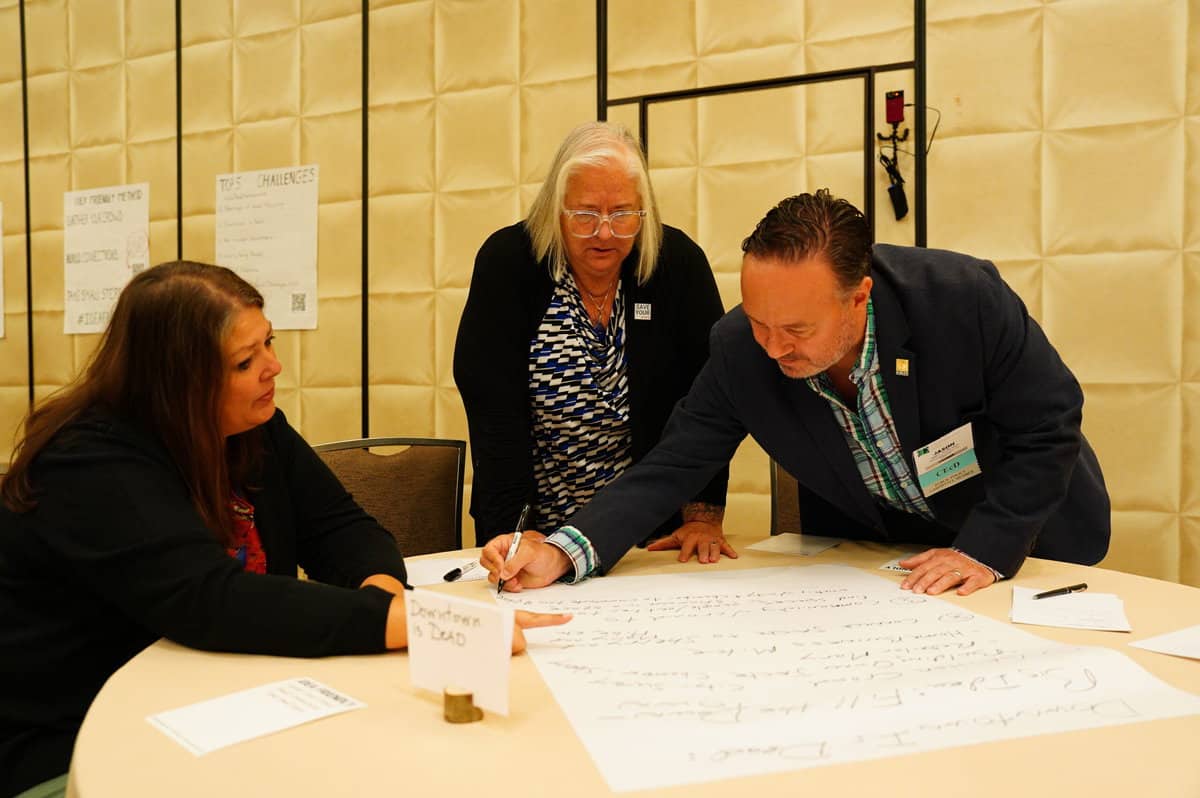
Photo courtesy of IEDC
Guest post by Deb Brown
What attendees learned from attending the Idea Friendly Session by SaveYour.Town at the International Economic Development Council Conference — Big Ideas you can copy in your town
Becky McCray and I were excited to lead an interactive Idea Friendly workshop at the International Economic Development Council Conference in Dallas in September of 2023.
The Idea Friendly Method is:
- You gather your crowd with a big idea.
- You turn that crowd into a capable network through building connections.
- You and the crowd accomplish the big idea through small steps.
What Happened in the Idea Friendly Workshop
Attendees developed their own Idea Friendly Projects after learning what Idea Friendly is and how to use it effectively in rural communities.
Engaging the audience, we asked what their rural challenges were. Not surprisingly, they aligned with the top 5 rural challenges on our Survey of Rural Challenges results:
- Shortage of good housing
- Downtown is dead
- Not enough volunteers
- Losing Young People
- Lack of Childcare
The attendees broke off into groups and chose a challenge to work on together. Each table had a flipchart sheet and the group worked the challenge through the Idea Friendly Method. The different groups presented their results to the entire room.
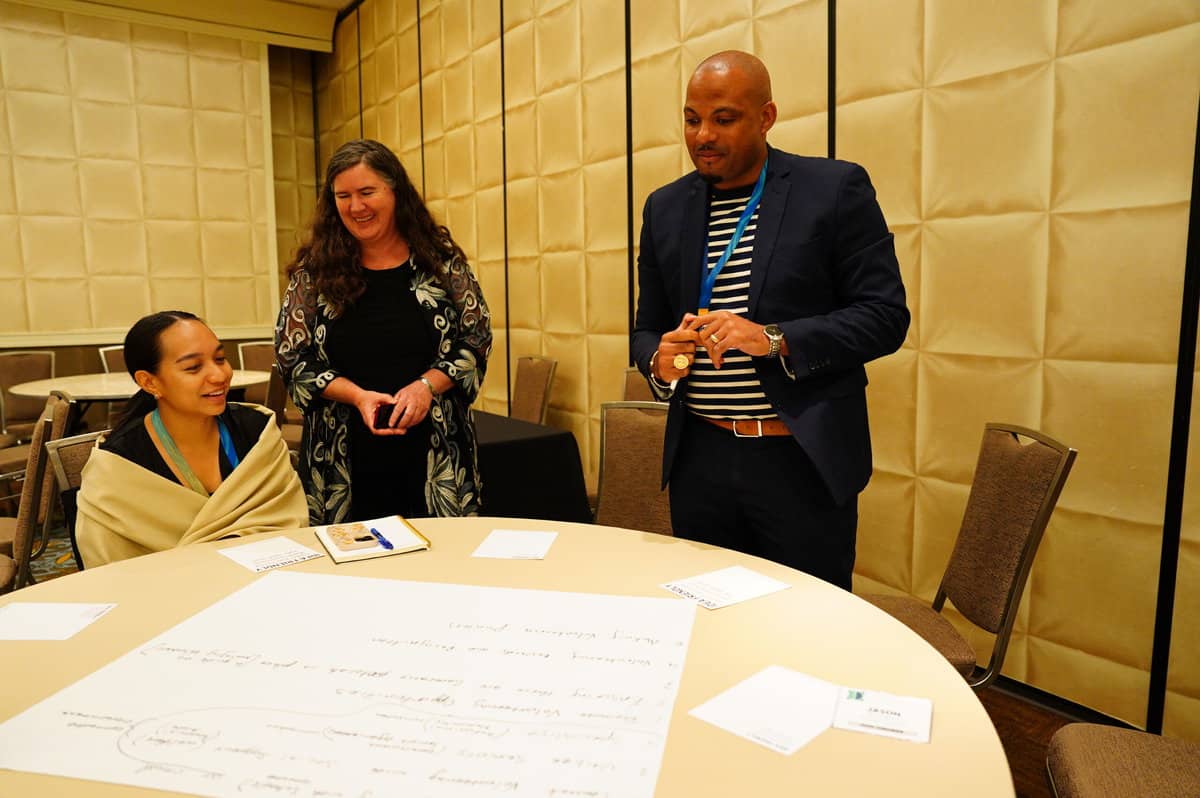
Photo courtesy of IEDC
What the Big Ideas were:
Challenge: Housing
Big Idea: Offsetting public infrastructure to incentivize private development
This idea brought to light the number of people who wanted help with a 12 unit housing development. The first small step they would take is to work with the economic development organization to find ways to bring the interested parties together for a conversation.
Challenge: Not enough volunteers
Big Idea: Volunteer engagement and involving the whole community
Their ideas included helping to promote all the possibilities for volunteering and creating a guide to managing volunteers ensuring any required government protocols are well explained. They created a brilliant tagline: making volunteering painless.
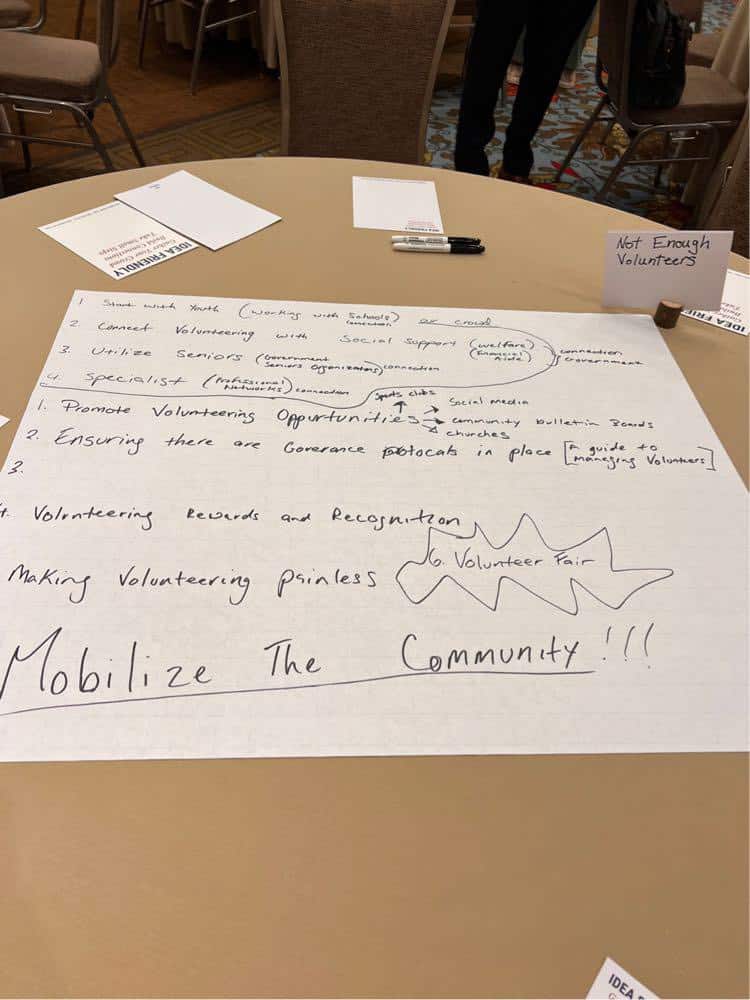
One attendee said to me, “Friend, I’m just a redneck from Alabama and I never get to meet people from other places. This was awesome!” Attendees came from the continental United States, Puerto Rico, Bermuda, Saipan, and Canada.
Challenge: Losing our young people
Big Idea: Helping youth boomerang back
This group was excited about working with different organizations and people to create a strong publicity campaign. This big idea uses storytelling and sharing the small wins with some catchy promotional pieces. “Wish you were here”, “While you were gone”, and “We’ve grown up” are some of the hooks to use in promoting the community to their audience of young people.
Big Idea: Downtown is dead
These folks took their big idea to fill the downtown and built out a list of who else wanted to work with them, and then built possible connections that could help get it done. They realized they were not alone and had others in their towns that wanted to help.
Challenge: Lack of childcare
Big Idea: Create a downtown childcare facility
After identifying a long list of people and organizations that would want to join this project, the group came up with the idea of playground “playdate” to bring them all together for productive discussion. They were excited to see how a new downtown childcare facility could not only improve the availability of childcare, but also spur downtown revitalization and contribute to positive placemaking.
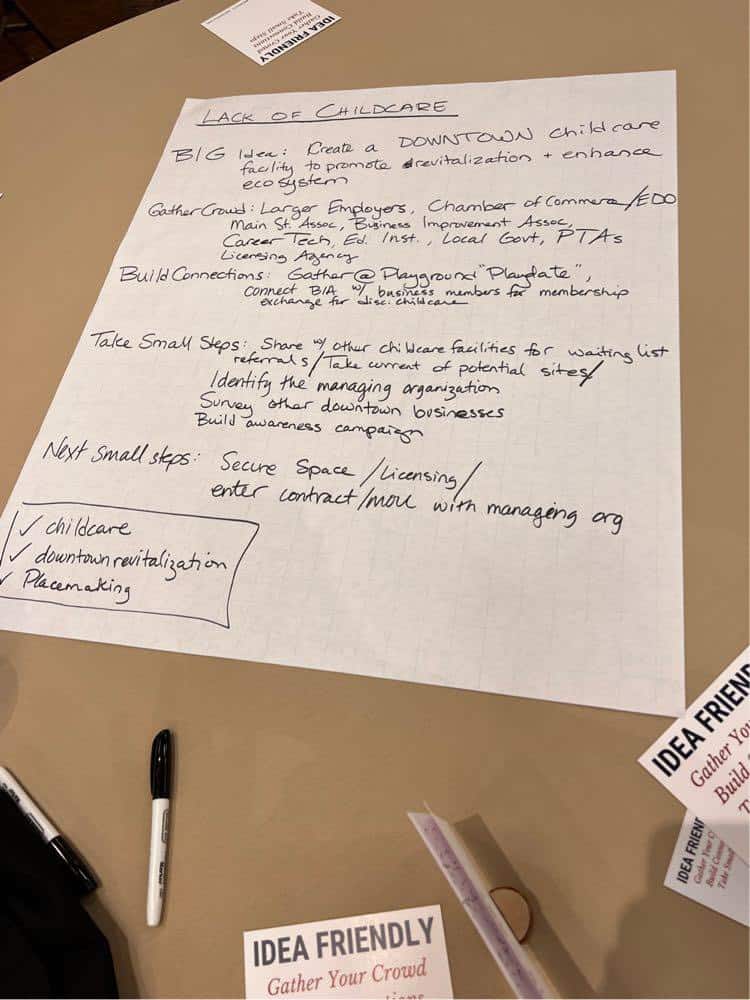
Creating Idea Friendly Projects is an easy to use and effective way to address our rural challenges.
This interactive IEDC session was a great success, and it was inspiring to see the plans the participants came up with to address the challenges they were facing. By working together and using innovative approaches, we can create more vibrant and resilient rural communities that are better equipped to face the challenges of the future.
“Thank you both so much for your preparation and execution of your session today! Sincerely, it was a true pleasure meeting and supporting you today. Your preparation and professionalism was reflected in your session. I appreciate your adaptability as well.”
Alexa Schultz, IEDC
Next steps:
- Reach out to SaveYour.Town about an Idea Friendly Workshop for your community or event
- Read more about the Idea Friendly Method.
- You can also watch a 24 minute Idea Friendly video for a $5 investment into your community.
- Don’t forget to sign up for our free weekly newsletter that addresses rural challenges!
